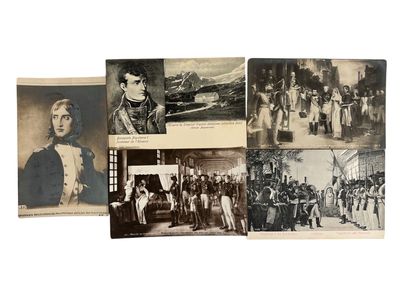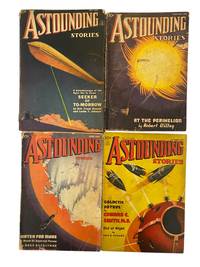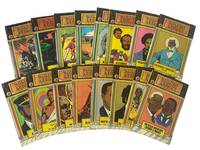by Bonaparte, Napoleon
Napoleon Bonaparte archive of 58 late 19th and early 20th century postcards depicting Napoleon Bonaparte at various points in his life and military career. Napoleon Bonaparte, a Corsican-born French general, rose to power during the French Revolution, becoming Emperor of France and dominating Europe through military conquests, but his ambition ultimately led to his defeat at Waterloo and exile to St. Helena. This archive of Printed late 19th and early 20th century postcards "Carte Postale", French illustrated postcards illustrate Napoleon’s life from his childhood, to his death in 1821. Many postcards include printed captions in French. The postcards cover his childhood home in Corsica, his participation in the French Revolutionary Wars, his marriages and coronation as Emperor, the battles of the Napoleonic Wars, and his final exile on Saint Helena. Furthermore, it provides a comprehensive visual record of late 18th- and early 19th-century European warfare, political maneuvering, and personal triumphs and losses of one of history’s most formidable military leaders.
One postcard, captioned “Napoléon Bonaparte Lieutenant-Colonel” and attributed to Philippoteaux, shows a young Napoleon in his early military career, wearing a high-collared jacket with shoulder epaulets and gazing off to the side. His youthful, unlined face captures his rise before becoming a general. Another card, captioned “Bonaparte Napoléon I fondateur de l’Hospice”, pairs a portrait of Napoleon in an ornately embroidered military uniform with an image of the Hospice du Simplon, a facility constructed along the Strada Napoleonica (Napoleonic Road) in the Alps, highlighting his contributions to infrastructure. Several postcards depict pivotal moments from the Napoleonic Wars. One, labeled “Napoléon à les Pyramides (1798–99) / Napoleone alle Piramidi”, captures a dramatized scene from the Egyptian Campaign, showing French troops in bicorne hats and blue coats lined up beneath palm trees, flanked by an image of the Virgin Mary. Another, “ Napoléon visite l’infirmerie des Invalides (11 Fevr. 1808)”, shows Napoleon visiting wounded soldiers at the Hôtel des Invalides, emphasizing his role as both a warrior and a leader attentive to his troops. A striking card titled “Musée de Versailles – M. Gosse – Napoléon reçoit la Reine de Prusse à Tilsitt” portrays the meeting between Napoleon and Queen Louise of Prussia at Tilsit in 1807. The elaborately staged composition shows the queen in an elegant white gown appealing to the emperor, while officers and courtiers observe. This scene references Napoleon’s negotiations after Prussia’s defeat, a moment that shaped European diplomacy. "La Garde Consulaire à Marengo – 14 Juin 1800" presents the elite troops advancing, highlighting the importance of this early victory in securing Napoleon’s rule. The postcard titled "Passage du Niemen – Juin 1812" visually narrates the commencement of the fateful Russian campaign, foreshadowing the devastating retreat from Moscow, which is depicted in "Retour de Moscou – 1812," where French troops trudge through snow, bodies frozen in the bitter winter. A finely curated collection reflecting Napoleon’s military, political and personal life, these postcards serve as historical artifacts documenting early 20th-century European perspectives on the Napoleonic era.'
Beyond battlefield depictions, the archive includes postcards that provide insight into Napoleon’s political and personal life, his marriages, and his family. "Entrée de Napoléon à Berlin – 27 Octobre 1806" captures his triumphant entry into the Prussian capital, signifying his dominance over Central Europe. "Reddition de Madrid – 1808" shows Napoleon negotiating the Spanish surrender, a moment emblematic of his influence across the continent. "Réception des Drapeaux d’Austerlitz" illustrates the grand ceremony in Notre-Dame where the standards captured in battle were displayed, reinforcing his legacy. More personal aspects of his life are documented in images such as "Naissance du Roi de Rome – 20 Mars 1811," marking the birth of his son, and an array of postcards featuring his childhood, family members, and interiors of his residences, including his Corsica family home, the Château de Malmaison’s where he lived with Josephine and St. Helena. The archive concludes with a powerful image of Napoleon’s tomb at the Hôtel des Invalides in Paris, serving as a final testament to his enduring impact on world history.
The postcards,are all very early and therefore primarily black-and-white with some colorized examples. The archive is in very good condition, with slight edge wear and occasional minor creasing. The detailed engravings and inscriptions remain clear and legible. This collection stands as a significant visual documentation of Napoleon’s military and personal journey, offering invaluable historical insight for collectors, scholars, and institutions interested in European history and military studies. (Inventory #: 21440)
One postcard, captioned “Napoléon Bonaparte Lieutenant-Colonel” and attributed to Philippoteaux, shows a young Napoleon in his early military career, wearing a high-collared jacket with shoulder epaulets and gazing off to the side. His youthful, unlined face captures his rise before becoming a general. Another card, captioned “Bonaparte Napoléon I fondateur de l’Hospice”, pairs a portrait of Napoleon in an ornately embroidered military uniform with an image of the Hospice du Simplon, a facility constructed along the Strada Napoleonica (Napoleonic Road) in the Alps, highlighting his contributions to infrastructure. Several postcards depict pivotal moments from the Napoleonic Wars. One, labeled “Napoléon à les Pyramides (1798–99) / Napoleone alle Piramidi”, captures a dramatized scene from the Egyptian Campaign, showing French troops in bicorne hats and blue coats lined up beneath palm trees, flanked by an image of the Virgin Mary. Another, “ Napoléon visite l’infirmerie des Invalides (11 Fevr. 1808)”, shows Napoleon visiting wounded soldiers at the Hôtel des Invalides, emphasizing his role as both a warrior and a leader attentive to his troops. A striking card titled “Musée de Versailles – M. Gosse – Napoléon reçoit la Reine de Prusse à Tilsitt” portrays the meeting between Napoleon and Queen Louise of Prussia at Tilsit in 1807. The elaborately staged composition shows the queen in an elegant white gown appealing to the emperor, while officers and courtiers observe. This scene references Napoleon’s negotiations after Prussia’s defeat, a moment that shaped European diplomacy. "La Garde Consulaire à Marengo – 14 Juin 1800" presents the elite troops advancing, highlighting the importance of this early victory in securing Napoleon’s rule. The postcard titled "Passage du Niemen – Juin 1812" visually narrates the commencement of the fateful Russian campaign, foreshadowing the devastating retreat from Moscow, which is depicted in "Retour de Moscou – 1812," where French troops trudge through snow, bodies frozen in the bitter winter. A finely curated collection reflecting Napoleon’s military, political and personal life, these postcards serve as historical artifacts documenting early 20th-century European perspectives on the Napoleonic era.'
Beyond battlefield depictions, the archive includes postcards that provide insight into Napoleon’s political and personal life, his marriages, and his family. "Entrée de Napoléon à Berlin – 27 Octobre 1806" captures his triumphant entry into the Prussian capital, signifying his dominance over Central Europe. "Reddition de Madrid – 1808" shows Napoleon negotiating the Spanish surrender, a moment emblematic of his influence across the continent. "Réception des Drapeaux d’Austerlitz" illustrates the grand ceremony in Notre-Dame where the standards captured in battle were displayed, reinforcing his legacy. More personal aspects of his life are documented in images such as "Naissance du Roi de Rome – 20 Mars 1811," marking the birth of his son, and an array of postcards featuring his childhood, family members, and interiors of his residences, including his Corsica family home, the Château de Malmaison’s where he lived with Josephine and St. Helena. The archive concludes with a powerful image of Napoleon’s tomb at the Hôtel des Invalides in Paris, serving as a final testament to his enduring impact on world history.
The postcards,are all very early and therefore primarily black-and-white with some colorized examples. The archive is in very good condition, with slight edge wear and occasional minor creasing. The detailed engravings and inscriptions remain clear and legible. This collection stands as a significant visual documentation of Napoleon’s military and personal journey, offering invaluable historical insight for collectors, scholars, and institutions interested in European history and military studies. (Inventory #: 21440)








